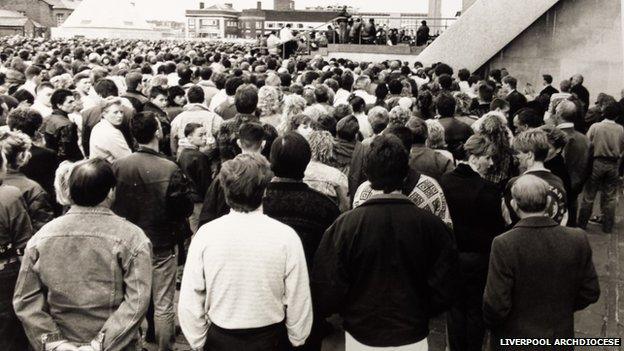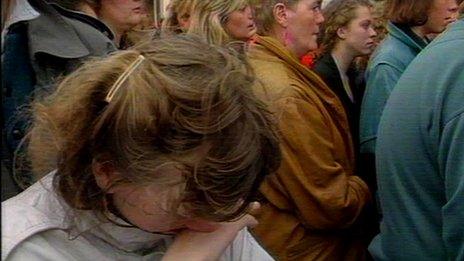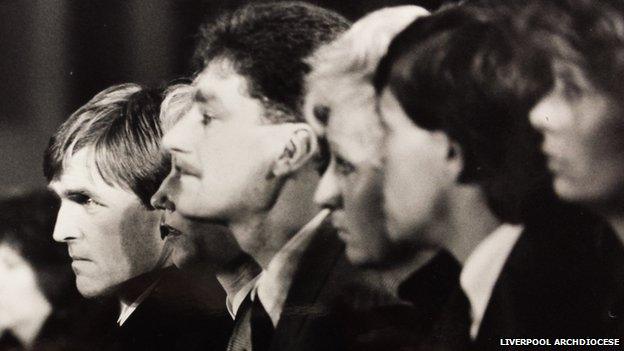Hillsborough tragedy: How a 'megaphone' Mass united fans
- Published

At least 6,000 people were outside the cathedral while inside there were more than 3,000
One day after the Hillsborough disaster - as the people of Liverpool struggled to comprehend the enormity of the tragedy - a remarkable service attended by 9,000 people took place at the city's Roman Catholic cathedral.
Just over 24 hours after Britain's worst football stadium tragedy, Monsignor Vincent Malone surveyed Liverpool Metropolitan Cathedral with a growing anxiety.
A requiem Mass had been hastily arranged in the aftermath of the disaster at the Liverpool v Nottingham Forest FA Cup semi-final in Sheffield, which would eventually cost the lives of 96 people.
"People were heading to the cathedral like ants," recalled parishioner Rita Pinto.
Press photographer Tom Murphy added: "People who claimed not to believe in God or faith just came to the cathedral because there was nowhere else to go."
As a priest, Monsignor Malone might be expected to be glad to see so many turning to the church in their hour of need but there was one snag - the cathedral looked to be reaching its 3,000 capacity nearly 90 minutes before the Mass was due to start at 18:00.

The service has been credited with helping the city cope with its grief
"People started arriving around 4:30 and it soon became pretty clear we seemed to be getting over-full," he recalled.
"This was the worst possible situation," he added.
He decided to close the cathedral immediately and conduct a simultaneous service on the piazza at the building's rear.
Consulting with the police he had an urgent request - for a megaphone.
So as fans, councillors and Liverpool first team members gathered inside for the start of a service, Monsignor Malone was walking to the rear of his cathedral where more than 6,000 people had massed.
In a freezing wind on a piazza, where in joyful times Pope John Paul II had gone on walkabout in 1982, the people had waited for the service as the Salvation Army band played.
"What sticks in my mind most is, as I walked round to the piazza, I could hear waves of applause and wondered if the Salvation Army Band were still playing like they had been for most of the afternoon," he said.
"When I got there I was very moved to see that the people were applauding as individuals placed their football scarves on the outdoor Altar.

At least one Liverpool player would attend every victim's funeral
"It was a very unusual experience, I thought my megaphone would be one where I held a talk piece to my mouth but instead I had to speak into the trumpet directly.
"I wish I had had the foresight to get a copy of Archbishop Derek Worlock's sermon - I could have read it out. The cathedral seemed to be the only place outside of Anfield where people could come together that day to express their corporate grief."
Electrician Tony Zeverona had initially been outside the cathedral with a friend who was begging to be let inside because he had lost a relative.
"The man on the door agreed and asked did I want to go with him and I said 'yes' - to be honest it was a bit of a blur," said Mr Zeverona, who had been in the stands at Hillsborough the day before.
Earlier he had visited an injured friend in a hospital in Sheffield before going to the Anfield stadium where fans were laying tributes.
"I got home and my wife told me about the cathedral service - I had to go. I think it helped a lot of people. The people of Liverpool really came together."
For Liverpool players, the Mass was the first of many services they would attend as the club arranged for at least one player to attend each victim's funeral.
Midfielder Ronnie Whelan said: "I attended the Catholic cathedral service but my memory is a bit hazy. I have stronger memories of the service at the Anglican cathedral [the following week].
"It was so sombre. Very, very emotional - especially when You'll Never Walk Alone was sung," he said. "It was very, very difficult - although much more difficult for the families.
"I attended two funerals. You feel a little bit guilty. What can you do? The families seemed to appreciate it though."
In the blue half of the city, some Everton fans felt awkward in the tragedy's aftermath.
"We were caught between not wanting to intrude almost - and perhaps be seen as a bit phoney or insincere - and not wanting to appear unconcerned," said Evertonian Greg Murphy.
"I often say that the city as a whole didn't know how to react until late on the Sunday.
"The cathedral service was a great catalyst for focusing everyone's attention, because by that stage people knew how big a disaster it had been and were coming to understand that this was a global news story and so the cathedral event served to validate people's grief.
"I recall people saying 'I don't know why I feel so bad, I don't even like football, I don't know anyone who was there, I didn't even know where Hillsborough was until yesterday - but I feel dreadful'.
"The cathedral event pulled all that together - for everyone."